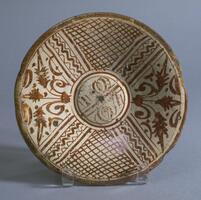96 UMMA Objects
96 UMMA Objects

Flemish (Flemish (culture or style))
The Rape of Europa
1567 – 1632
Bequest of Margaret Watson Parker
1955/1.186
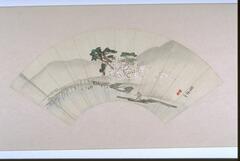
Kishi Renzan
Spring blossoms at Arashiyama
1830 – 1859
Museum purchase made possible by the Margaret Watson Parker Art Collection Fund
1964/1.97
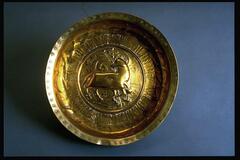
1567 – 1632
The Paul Leroy Grigaut Memorial Collection
1969/2.92
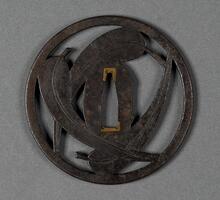
Sadanobu
Tsuba (Sword guard)
17th century
Museum purchase made possible by the Margaret Watson Parker Art Collection Fund
1966/1.103

Flemish (Flemish (culture or style))
Tapestry;Border Fragment (Central cartouche depicting 'Atlanta and the Caledonia
1567 – 1632
Gift of Colonel and Mrs. Thomas M. Spaulding
1967/2.14
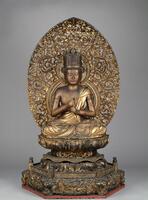
Japanese (Japanese (culture or style))
Vairocana Buddha (Japanese, Dainichi Nyorai)
17th century
Museum purchase made possible by the Margaret Watson Parker Art Collection Fund
2003/2.59.1
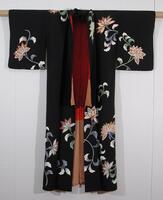
Japanese (Japanese (culture or style))
Black kimono with painted and gilt floral designs
1940 – 1950
Gift of Howard and Patricia Yamaguchi
2005/1.389

Cornelis Dusart
The Seated Violinist
1685
Museum Purchase made possible by the Friends of the Museum of Art
1992/2.18
![Burial wares are those placed in tombs as a way of praying for the continued happiness and comfort of the deceased in the afterlife. Offering vessels produced in the Joseon period included smaller reproductions of the vessels used every day, such as jars, boxes, and bowls, among others. The University of Michigan Museum of Art houses a set of white porcelain offering vessels buried in pit graves between the late 16th century and early 17th century. The vessels are coated in pale blue glaze but generally tinged with gray. They were fired without using saggers, while resting on fine sand supports. Their glaze is relatively well applied and fused. The cintamani-shaped knobs on the lids are similar to those found on the lids of vessels produced at white porcelain kilns near Seondong-ri and Songjeong-ri in Gwangju-si, Gyeonggi-do in the 17th century.<br />
[Korean Collection, University of Michigan Museum of Art (2014) p.188] Burial wares are those placed in tombs as a way of praying for the continued happiness and comfort of the deceased in the afterlife. Offering vessels produced in the Joseon period included smaller reproductions of the vessels used every day, such as jars, boxes, and bowls, among others. The University of Michigan Museum of Art houses a set of white porcelain offering vessels buried in pit graves between the late 16th century and early 17th century. The vessels are coated in pale blue glaze but generally tinged with gray. They were fired without using saggers, while resting on fine sand supports. Their glaze is relatively well applied and fused. The cintamani-shaped knobs on the lids are similar to those found on the lids of vessels produced at white porcelain kilns near Seondong-ri and Songjeong-ri in Gwangju-si, Gyeonggi-do in the 17th century.<br />
[Korean Collection, University of Michigan Museum of Art (2014) p.188]](/media/W1siZiIsIjIwMjIvMDkvMjQvMmFsZnFybWRwaF9kZWZhdWx0LmpwZyJdLFsicCIsInRodW1iIiwiMjQweDIwMCJdXQ?sha=19cfe56e758baf7a)
Korean (Korean (culture or style))
Burial Set (15 plates, 16 bowls and 6 lids)
17th century
Gift of Ok Ja Chang and the Chang Family
2009/2.79.7
![Burial wares are those placed in tombs as a way of praying for the continued happiness and comfort of the deceased in the afterlife. Offering vessels produced in the Joseon period included smaller reproductions of the vessels used every day, such as jars, boxes, and bowls, among others. The University of Michigan Museum of Art houses a set of white porcelain offering vessels buried in pit graves between the late 16th century and early 17th century. The vessels are coated in pale blue glaze but generally tinged with gray. They were fired without using saggers, while resting on fine sand supports. Their glaze is relatively well applied and fused. The cintamani-shaped knobs on the lids are similar to those found on the lids of vessels produced at white porcelain kilns near Seondong-ri and Songjeong-ri in Gwangju-si, Gyeonggi-do in the 17th century.<br />
[Korean Collection, University of Michigan Museum of Art (2014) p.188] Burial wares are those placed in tombs as a way of praying for the continued happiness and comfort of the deceased in the afterlife. Offering vessels produced in the Joseon period included smaller reproductions of the vessels used every day, such as jars, boxes, and bowls, among others. The University of Michigan Museum of Art houses a set of white porcelain offering vessels buried in pit graves between the late 16th century and early 17th century. The vessels are coated in pale blue glaze but generally tinged with gray. They were fired without using saggers, while resting on fine sand supports. Their glaze is relatively well applied and fused. The cintamani-shaped knobs on the lids are similar to those found on the lids of vessels produced at white porcelain kilns near Seondong-ri and Songjeong-ri in Gwangju-si, Gyeonggi-do in the 17th century.<br />
[Korean Collection, University of Michigan Museum of Art (2014) p.188]](/media/W1siZiIsIjIwMjIvMDkvMjQvOWlpdDg4YXNlcF9kZWZhdWx0LmpwZyJdLFsicCIsInRodW1iIiwiMjQweDIwMCJdXQ?sha=16d2250d13230546)
Korean (Korean (culture or style))
Burial Set (15 plates, 16 bowls and 6 lids)
17th century
Gift of Ok Ja Chang and the Chang Family
2009/2.79.9
![Burial wares are those placed in tombs as a way of praying for the continued happiness and comfort of the deceased in the afterlife. Offering vessels produced in the Joseon period included smaller reproductions of the vessels used every day, such as jars, boxes, and bowls, among others. The University of Michigan Museum of Art houses a set of white porcelain offering vessels buried in pit graves between the late 16th century and early 17th century. The vessels are coated in pale blue glaze but generally tinged with gray. They were fired without using saggers, while resting on fine sand supports. Their glaze is relatively well applied and fused. The cintamani-shaped knobs on the lids are similar to those found on the lids of vessels produced at white porcelain kilns near Seondong-ri and Songjeong-ri in Gwangju-si, Gyeonggi-do in the 17th century.<br />
[Korean Collection, University of Michigan Museum of Art (2014) p.188] Burial wares are those placed in tombs as a way of praying for the continued happiness and comfort of the deceased in the afterlife. Offering vessels produced in the Joseon period included smaller reproductions of the vessels used every day, such as jars, boxes, and bowls, among others. The University of Michigan Museum of Art houses a set of white porcelain offering vessels buried in pit graves between the late 16th century and early 17th century. The vessels are coated in pale blue glaze but generally tinged with gray. They were fired without using saggers, while resting on fine sand supports. Their glaze is relatively well applied and fused. The cintamani-shaped knobs on the lids are similar to those found on the lids of vessels produced at white porcelain kilns near Seondong-ri and Songjeong-ri in Gwangju-si, Gyeonggi-do in the 17th century.<br />
[Korean Collection, University of Michigan Museum of Art (2014) p.188]](/media/W1siZiIsIjIwMjIvMDkvMjQvMzhxM2dveGoxeV9kZWZhdWx0LmpwZyJdLFsicCIsInRodW1iIiwiMjQweDIwMCJdXQ?sha=9c9b42b61d748008)
Korean (Korean (culture or style))
Burial Set (15 plates, 16 bowls and 6 lids)
17th century
Gift of Ok Ja Chang and the Chang Family
2009/2.79.11
Loading…
